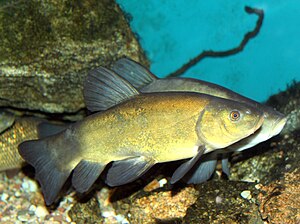Tench
| Tench | |
|---|---|

| |
| Scientific classification | |
| Domain: | Eukaryota |
| Kingdom: | Animalia |
| Phylum: | Chordata |
| Class: | Actinopterygii |
| Order: | Cypriniformes |
| Suborder: | Cyprinoidei
|
| Family: | Tincidae Jordan, 1878 |
| Genus: | Tinca Garsault, 1764[2] |
| Species: | T. tinca
|
| Binomial name | |
| Tinca tinca | |
| Synonyms | |
| |
The tench or doctor fish (Tinca tinca) is a
Taxonomy
The tench was formerly classified in the subfamily Leuciscinae with other Eurasian minnows, but more recent phylogenetic studies have supported it belonging to its own family Tincidae.[7][8]
Ecology
The tench is most often found in still waters with a clay or muddy substrate and abundant vegetation.[9] This species is rare in clear waters across stony substrate, and is absent altogether from fast-flowing streams. It tolerates water with a low oxygen concentration,[3] being found in waters where even the carp cannot survive.[9]

Tench feed mostly at night with a preference for animals, such as
Breeding takes place in shallow water usually among aquatic plants where the sticky green eggs can be deposited.[3] Spawning usually occurs in summer,[5] and as many as 300,000 eggs may be produced.[12] Growth is rapid, and fish may reach a weight of 0.11 kg (0.25 lb) within the first year.
Morphology
Tench have a stocky, carp-like shape and olive-green skin, darker above and almost golden below. The
Maximum size is 70 cm (28 in), though most specimens are much smaller.[14] A record fish caught in 2001 in England had a weight of 15 lb 3.4 oz (6.899 kg).[15] The eyes are small and red-orange in colour.[3] Females can reach weights of around 7 kg (15 lb), although 4 kg (8.8 lb) is considered large. Males rarely reach over 3 kg (6.5 lb).[3] Sexual dimorphism is strong, males can be recognised by having larger, more curved pelvic fins extending beyond the anus[16] and noticeable muscles around the base of these fins generally absent in females. Males also possess a very thick and flattened outer ray to the ventral fins.[13] Adult females may have a more convex ventral profile when compared with males.[14]
The tench has very small scales, which are deeply embedded in a thick skin, making it as slippery as an eel.[13] Folklore has it that this slime cured any sick fish that rubbed against it, and from this belief arose the name doctor fish.[12]

Golden tench
An artificially bred variety of tench called the golden tench is a popular ornamental fish for ponds. This form varies in colour from pale gold through to dark red, and some fish have black or red spots on the flanks and fins. Though somewhat similar to the goldfish, because these fish have such small scales, their quality is rather different.[12]
Economic significance
Tench are edible, working well in recipes that would otherwise call for carp, but are rarely eaten these days.
Angling
Large tench may be found in gravel pits or deep, slow-moving waters with a clayey or silty bottom and copious aquatic vegetation. The best methods and bait to catch tench are float fishing and ledgering with a swim feeder using maggots, sweetcorn, pellets, bread, and worms. Fish over 1 kg (2 lb) in weight are very strong fighters when caught on a rod.[18]
References
- . Retrieved 19 November 2021.
- ^ Eschmeyer, William N.; Fricke, Ron & van der Laan, Richard (eds.). "Genera in the family Tinca". Catalog of Fishes. California Academy of Sciences. Retrieved 27 November 2020.
- ^ a b c d e f Froese, Rainer; Pauly, Daniel (eds.) (2007). "Tinca tinca" in FishBase. May 2007 version.
- ^ Maxim Anikin, ed. (2020). "Baikal lake fish, fish species of lake". Baikal Royal Safari.
- ^ a b B. Whitton (1982). Rivers, Lakes and Marshes p 163. Hodder & Staughton, London.
- ^ "Tench". BadAngling. Retrieved 2018-07-06.
- S2CID 49292104.
- ^ "Family TINCIDAE Jordan 1878 (Tench)". The ETYFish Project. 31 May 2023. Retrieved 23 January 2024.
- ^ a b c d e A. F. Magri MacMahon (1946). Fishlore, pp 156-158. Pelican Books.
- .
- JSTOR 1939640.
- ^ a b c A. Lawrence Wells (date unknown). Observer Book of Freshwater Fishes, pp 101-105. Frederick Warne & Co.
- ^ a b c One or more of the preceding sentences incorporates text from a publication now in the public domain: Chisholm, Hugh, ed. (1911). "Tench". Encyclopædia Britannica. Vol. 26 (11th ed.). Cambridge University Press. p. 61.
- ^ a b G. Sterba (1962). Freshwater Fishes of the World pp 249-250. Vista Books, London.
- ^ "Coarse Fish Records as at July 2021" (PDF). British Record Fish Committee. Angling Trust. 19 July 2021. Retrieved 22 January 2024.
- PMID 33652872.
- ISBN 1-903098-10-6
- ^ A. Lawrence Wells (date unknown). Observer Book of Freshwater Fishes, pp 101-103. Frederick Warne & Co.

